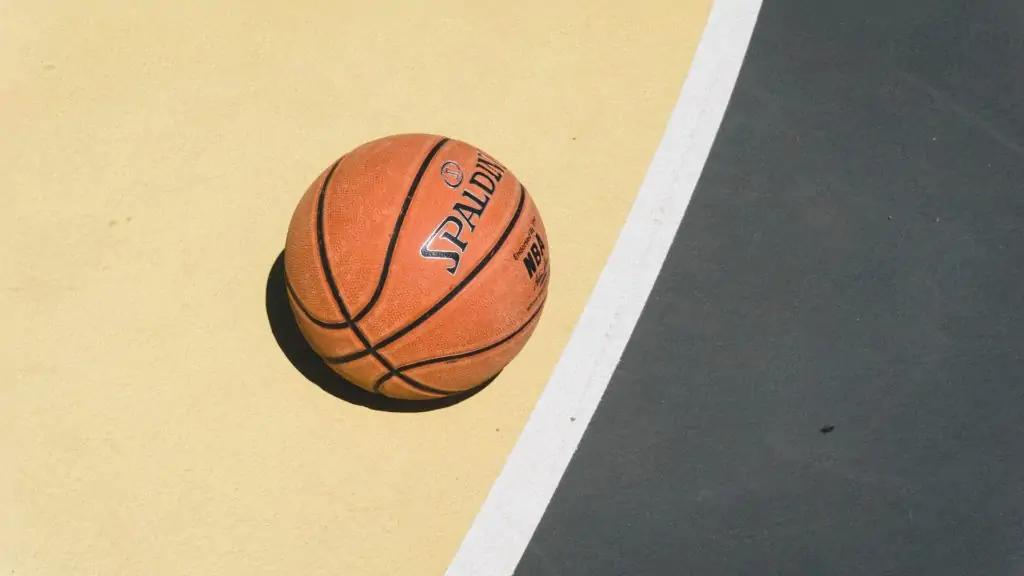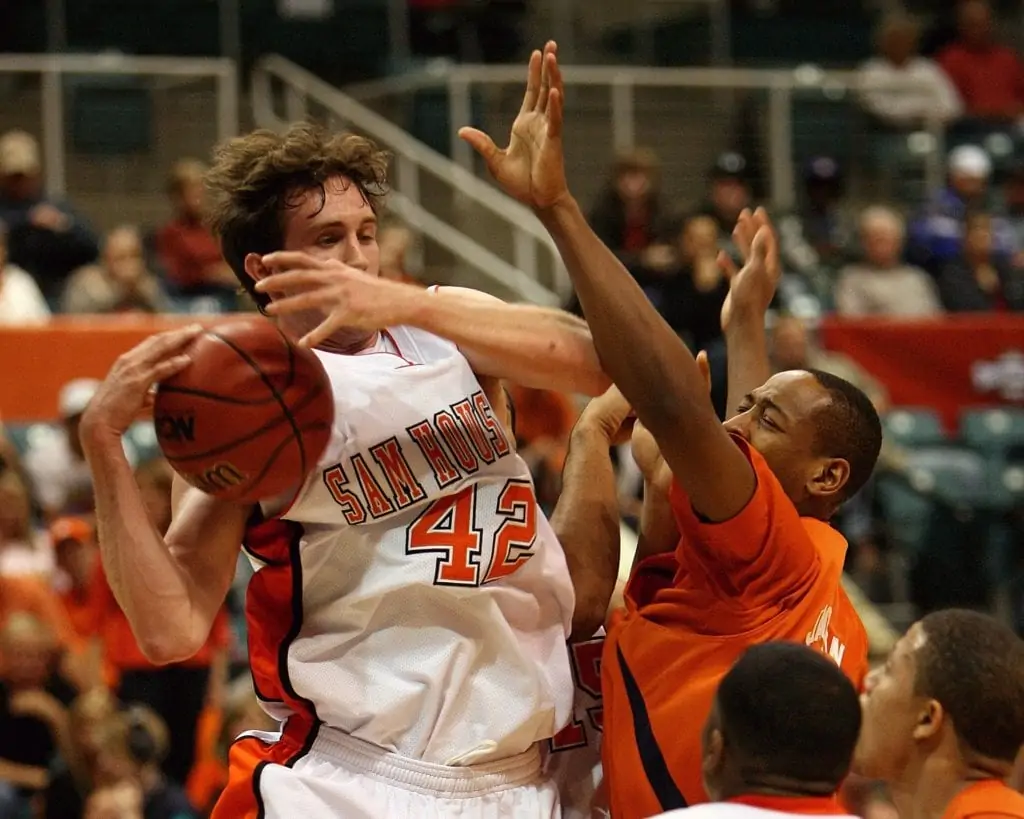Rules in the NBA have evolved throughout the years, and discarding one defensive move in the 2004-05 season might have ushered a new era of basketball. That defensive move is known as “hand checking.” So, really, what is the hand checking rule in the NBA? Before we delve deeper into that, we encourage all NBA fans to be aware of the rules and rule changes happening in the league. Knowing the nuances of these guidelines will help you understand the limits it imposes, especially on defensive players.
 What is a Hand Check in Basketball?
What is a Hand Check in Basketball?
A hand check is when a defender places his hand on an opponent (possibly in the hip or back area of the offensive player) to impede his progress and even maneuver him into the path the defender wants him to take. Usually, a defender was allowed to hand check if he was guarding the player with the ball. Off the ball, defenders can probably get away with more, or at least, could play defense as hard as the referee allows.
Hand checking was legal in the NBA until the 2003-04 season. The following year, hand checking was banned in the perimeter, freeing up the guards to roam and penetrate without the fear of being manhandled.
The NBA hoped to acquire more fans by bringing about a rule change that would encourage more offense. Many analysts think the banning of hand checks in the perimeter flipped the script when it comes to winning championships. They say it is no longer required to have a top 5 defense to be champion; you can win in it all with a mediocre defense and a top- 5 offense.
That take has not been spot on, but it is right in some respects. The 2016 champions Cleveland Cavaliers and the 2018 champions Golden State Warriors were only ranked 10th and 11th, respectively, in defensive rating in the regular season. However, the two teams were both No. 3 in offensive rating in the regular season during their championship runs.
 Is Hand Checking Legal in High School Basketball?
Is Hand Checking Legal in High School Basketball?
No, hand checking is not legal in high school basketball.
To be fair, high school basketball games are not easy to officiate because of the differences in teams’ playstyles. Many simply employ presses and run their opponents to the ground, so it’s not easy to identify hand checks at that level. However, at least two high school organizations– the University Interscholastic League (UIL in Texas) and the SDHSAA (South Dakota High School Activities Association– have formally announced their no hand-check rules.
The SDHSAA’s guidelines on hand checking are as follows:
It will be considered a hand check if,
1. The defender left his hand on the opponent.
2. The defender always puts his hand on the opponent.
3. The defender places both hands on the opponent.
4. The defender constantly jabs at the opponents.
5. The defender executes an illegal armbar.
The SDHSAA highlights that hand-checking early in the game will incur unpenalized warnings at first. However, if the defensive players continue to disregard the officials’ warnings, these fouls will be called to enforce the rules.
The University Interscholastic League had the same rule for the schools in its jurisdiction. The rule’s exact words were: The following acts constitute a foul when committed against a ball handler/dribbler: a. Placing two hands on the player. b. Placing an extended arm bar on the player. c. Placing and keeping a hand on the player. d. Contacting the player more than once with the same hand or alternating hands.
No matter how inconsistent the calls are at the high school level, the bottom line is that hand checking is not allowed in high school basketball. How frequent or infrequent the whistles are is a story for another day.
 Is Hand Checking Allowed in College Basketball?
Is Hand Checking Allowed in College Basketball?
All basketball levels have cracked down on hand checking, and it seems like college basketball is no different. After all, what’s the point of holding on to the rule if the ultimate destination, the NBA, has already abolished it?
Section 5 of the NCAA’s rulebook was specifically about hand checking (or Impeding the Progress of a Player). It states:
To curtail hand-checking, officials must address it at the beginning of the game, and related personal fouls must be called consistently throughout the game. Some guidelines for officials to use when officiating hand-checking:
1. When a defensive player keeps a hand or forearm on an opponent, it is a personal foul.
2. When a defensive player puts two hands on an opponent, it is a personal foul.
3. When a defensive player continually jabs by extending his arm(s) and placing a hand or forearm on the opponent, it is a personal foul.
4. When a defensive player uses an arm bar to impede the progress of a dribbler, it is a personal foul.
The NCAA’s hand-checking was the focal point of rule changes back in the opening of the 2013-14 season. Like many reforms, it was met with mixed emotions, but ultimately, long-time Big 12 conference official Curtis Shaw said putting a forearm on an opponent is not the way to play defense.
“I will tell you, the focus of playing tough, physical defense was never the game of basketball,” Shaw said. “So I think we are just going back to the rules of basketball, saying let’s go back to playing an athletic game, not a physical game.”
“The forearm is our kids’ favorite move these days,” Shaw said. “It’s a foul. Don’t play with your arms on the offensive player.”
 Why Was Hand Check Banned in the NBA?
Why Was Hand Check Banned in the NBA?
Before touching why the hand check was banned in the NBA, it is important to note that in the mid-90s to early 2000s, the league was full of good defensive teams. It was still an era where giants roam the hardwood– from Shaquille O’Neal to David Robinson to Tim Duncan to Hakeem Olajuwon. Because of this, teams often try to slow the pace down, dump the ball inside, and then come back the other way and defend.
Well, that’s not a wrong way to play the game, in our humble opinion. Guards rarely venture in the paint, and if someone scores down there, they will feel the contact. As tenacious as that style of play was, the NBA ultimately decided low-scoring, grind-it-out games do not translate to revenue. They want more fast-paced and free-flowing games,
That’s why the league began to implement rule changes to take effect in the 2001-02 season. Among these rules was the scrapping of illegal defense, more vigorous implementation of the three-second rule, and the shift from 10 seconds to eight seconds before getting a backcourt violation call. Because zone defenses are not allowed, it forced players to embrace the team concept and not rely on isolation plays to bail them out.
As mentioned, the banning of hand checking fits into the mold of what the NBA wants the games to be– more movement and more offense. Not only that, but it also forced players to work on every skill, especially shooting, to space the floor and keep defenses honest. Since the elimination of hand checks, there are no more traditional big men who have won an MVP since Tim Duncan and Shaquille O’Neal.
Of course, the changes were not immediately seen, but from what we see today, the points per game average of the league is the highest it has been since 1970-71. The average offensive rating was also the highest since the statistic was recorded first in 1973-74.
 Is there a Penalty for Hand checking?
Is there a Penalty for Hand checking?
Hand checks are going to be counted as a personal foul. A player could get himself and his team in heaps of trouble if he does not have the discipline to resist hand checking. In the NBA, a team can only accumulate five fouls per quarter before getting into penalty. In “penalty” means every defensive foul that follows are free throws for the other camp.
Additionally, a player could also get himself tossed out in the game if he commits six fouls. Either way would not be a good situation.
Wrapping Things Up: Hand Checking Rule in the NBA
When Dr. Naismith invented basketball back in 1891 inside Springfield College walls, his most optimistic forecast would have paled in comparison to how popular the sport has become. It has become so popular that the NBA is the third-highest grossing professional sports league in America. What’s more, the original 13 rules that Naismith formulated has essentially become an encyclopedia today.
One of those rules that the NBA changed is the abolition of the hand checking rule. Along with other rule changes, the purpose is to open the game up by disallowing defensive players to impede an offensive player’s progress. That way, every advantage is given to the offensive player.
Now, if you think about it, excessive hand checking has always been illegal, but like the dribbling violations of today, it was rarely called. Hence, by explicitly stating that hand checks are not allowed (especially in the perimeter), it’s an order for the referees to never swallow the whistle when they see cases of hand checking.
Again, the NBA got rid of hand checks because it wants a more free-flowing and exciting brand of basketball. Of course, more offense does not automatically equate to more excitement; defense is still as important as putting the ball in the basket. However, since the NBA is ultimately a multi-billion dollar business, it would make sense to create a product that they think would bring more revenue.
Therefore, in retrospect, what is the hand checking rule in the NBA? It is when a defensive player extends his hands and puts it on the offensive player to impede his progress. (Usually, this action happens in the perimeter.) That was allowed before the 2004-05 season but has since been abolished, resulting in a noticeable increase in offensive production. The NBA has made other rule changes to favor the offense, so it’s unfair to say that this rule alone caused the overall scoring boost. However, it would also not be right to exclude the hand check rule abolition out of the conversation altogether.
Did you find this helpful? Then also check out other basketball FAQ articles here.
> What is a Defensive Three-Second Violation in Basketball?
> How to Defend Ball Screens in Basketball

 What is a Hand Check in Basketball?
What is a Hand Check in Basketball?  Is Hand Checking Legal in High School Basketball?
Is Hand Checking Legal in High School Basketball?
 Is Hand Checking Allowed in College Basketball?
Is Hand Checking Allowed in College Basketball?  Why Was Hand Check Banned in the NBA?
Why Was Hand Check Banned in the NBA?
 Is there a Penalty for Hand checking?
Is there a Penalty for Hand checking?

